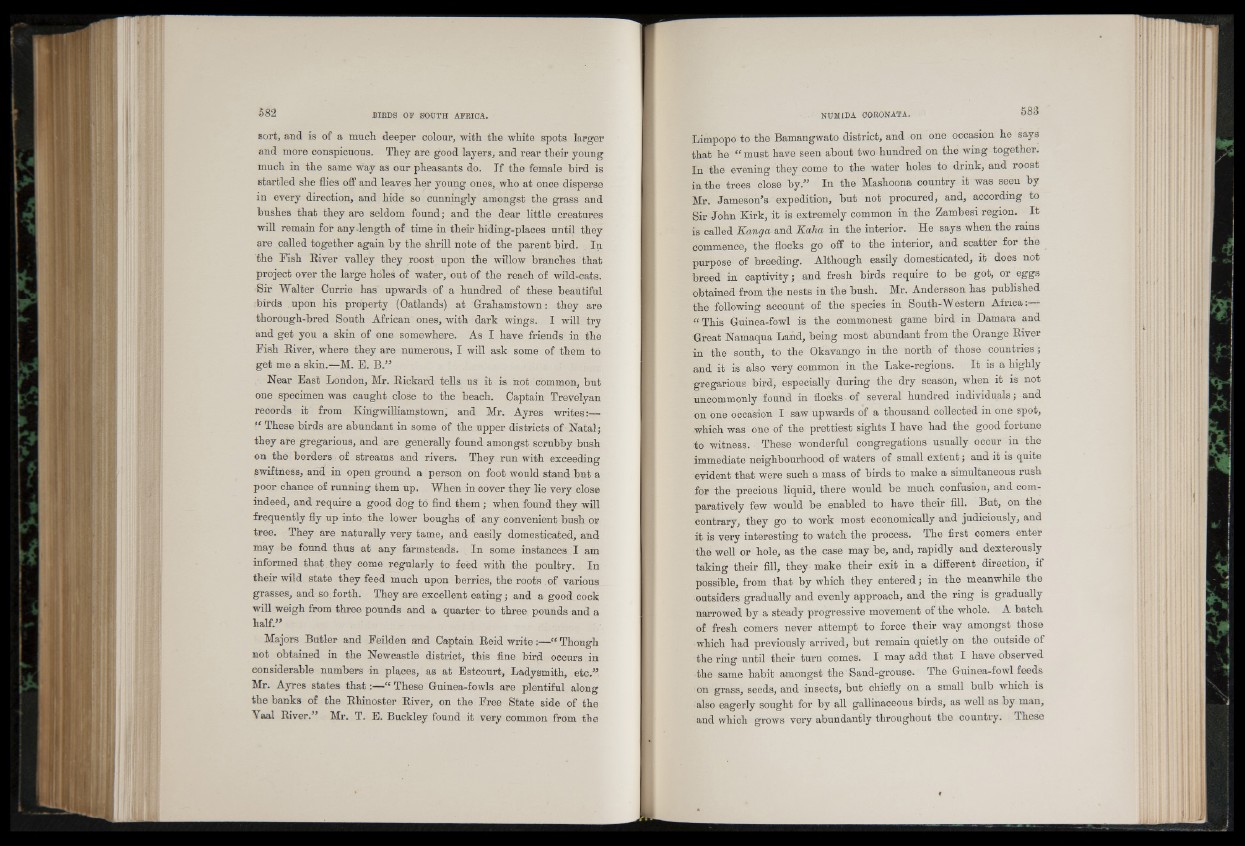
sort, and is of a nmol, deeper colour, with the white spots larger
and more conspicuous. They are good layers, and rear their young
much in the same way as our pheasants do. If the female bird is
startled she flies off and leaves her young ones, who at once disperse
in every direction, and hide so cunningly amongst the grass and
bushes that they are seldom found; and the dear little creatures
will remain for any-length of time in their hiding-places until they
are called together again by the shrill note of the parent bird. In
the Fish River valley they roost upon the willow branches that
project over the large holes of Water, out of the reach of wild-cats.
Sir Walter Currie has upwards of a hundred of these beautiful
birds upon his property (Oatlands) at Grahamstown: they are
thorough-bred South African ones, with dark wings. I will try
and get you a skin of one somewhere. As I have friends in the
Fish River, where they are numerous, I will ask some of them to
get me a skin.—M. E. B.”
Near East London, Mr. Rickard tells us it is not common, but
one specimen was caught close to the beach. Captain Trevelyan
records it from Kingwilliamstown, and Mr. Ayres writes:—
ff These birds are abundant in some of the upper districts of Natal;
they are gregarious, and are generally found amongst scrubby bush
on the borders of streams and rivers. They run with exceeding
swiftness, and in open ground a person on foot would stand but a
poor chance of running them up. When in cover they lie very close
indeed, and require a good dog to find them; when found they will
frequently fly up into the lower boughs of any convenient bush or
tree. They are naturally very tame, and easily domesticated, and
may be found thus at any farmsteads. In some instances I am
informed that they come regularly to feed with the poultry. In
their wild state they feed much upon berries, the roots of various
grasses, and so forth. They are excellent eating; and a good cock
will weigh from three pounds and a quarter- to three pounds and a
half.”
Majors Butler and Feilden and Captain Reid write:—“ Though
not obtained in the Newcastle district, this fine bird occurs in
considerable numbers in places, as at Estcourt, Ladysmith, etc.”
Mr. Ayres states th a t:—* These Guinea-fowls are plentiful along
the banks of the Rhinoster River, on the Free State side of the
Yaal River.” Mr. T. E. Buckley found it very common from the
Limpopo to the Bamangwato district, and on one occasion he says
that he “ must have seen about two hundred on the wing together.
In the evening they come to the water holes to drink, and roost
in the trees close by.” In the Mashoona country it was seen by
Mr. Jameson’s expedition, but not procured, and, according to
Sir John Kirk, it is extremely common in the Zambesi region. It
is called Kang a and Kaha in the interior. He says when the rams
commence, the flocks go off to the interior, and scatter for the
purpose of breeding. Although easily domesticated, it does not
breed in captivity; and fresh birds require to be got, or eggs
obtained from the nests in the bush. Mr. Andersson has published
the following account of the species in South-Western Africa:
“ This Guinea-fowl is the commonest game bird in Damara and
Great Namaqua Land, being most abundant from the Orange River
in the south, to the Okavango in the north of those countries;
and it is also very common in the Lake-regions. It is a highly
gregarious bird, especially during the dry season, when it is not
uncommonly found in flocks of several hundred individuals; and
on one occasion I saw upwards of a thousand collected in one spot,
which was one of the prettiest sights I have had the good fortune
to witness. • These wonderful congregations usually occur in the
immediate neighbourhood of waters of small extent; and it is quite
evident that were such a mass of birds to make a simultaneous rush
for the precious liquid, there would be much confusion, and comparatively
few would be enabled to have their fill. But, on the
contrary, they go to work most economically and judiciously, and
it is very interesting to watch the process. The first comers enter
the well or hole, as the case may be, and, rapidly and dexterously
taking their fill, they make their exit in a different direction, if
possible, from that by which they entered; in the meanwhile the
outsiders gradually and evenly approach, and the ring is gradually
narrowed by a steady progressive movement of the whole. A batch
of fresh comers never attempt to force their way amongst those
which had previously arrived, but remain quietly on the outside of
the ring until their turn comes. I may add that I have observed
the same habit amongst the Sand-grouse. The Guinea-fowl feeds
on grass, seeds, and insects, but chiefly on a small bulb which is
also eagerly sought for by all gallinaceous birds, as well as by man,
and which grows very abundantly throughout the country. These